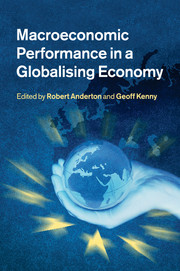Book contents
- Frontmatter
- Contents
- List of figures
- List of tables
- Notes on contributors
- Foreword by Jürgen Stark
- Acknowledgements
- 1 Globalisation and macroeconomic performance
- 2 The impact of globalisation on the euro area macroeconomy
- 3 Trade and foreign direct investment in business services: a modelling approach
- 4 Entry dynamics and the decline in exchange-rate pass-through
- 5 Does the exchange rate belong in monetary policy rules? New answers from a DSGE model with endogenous tradability and trade frictions
- 6 Globalisation and inflation in the OECD economies
- 7 Globalisation and euro area prices and labour markets: some evidence on the impact of low-cost countries
- 8 Monetary policy strategy in a global environment
- 9 Monetary policy in a global economy: past and future research challenges
- Index
- References
5 - Does the exchange rate belong in monetary policy rules? New answers from a DSGE model with endogenous tradability and trade frictions
Published online by Cambridge University Press: 04 February 2011
- Frontmatter
- Contents
- List of figures
- List of tables
- Notes on contributors
- Foreword by Jürgen Stark
- Acknowledgements
- 1 Globalisation and macroeconomic performance
- 2 The impact of globalisation on the euro area macroeconomy
- 3 Trade and foreign direct investment in business services: a modelling approach
- 4 Entry dynamics and the decline in exchange-rate pass-through
- 5 Does the exchange rate belong in monetary policy rules? New answers from a DSGE model with endogenous tradability and trade frictions
- 6 Globalisation and inflation in the OECD economies
- 7 Globalisation and euro area prices and labour markets: some evidence on the impact of low-cost countries
- 8 Monetary policy strategy in a global environment
- 9 Monetary policy in a global economy: past and future research challenges
- Index
- References
Summary
Introduction
The benefits of exchange-rate flexibility lie in its ability to change the relative prices of goods in the presence of nominal rigidities. Friedman (1953) first argued that a flexible exchange-rate regime is desirable as a shock absorber, and this has been followed by a long subsequent literature. The implications for the conduct of domestic monetary policy have, however, been the subject of much debate. In the closed-economy literature, several important papers have found that welfare-optimising monetary policy results in a complete stabilisation of the domestic price level, with no trade-off between output gap stabilisation and domestic price stability. Many key contributions to the recent open-economy literature have found conditions under which these results carry over to an open economy setting, meaning specifically that there is no need for monetary policy to explicitly consider the exchange rate. However, these papers share a common set of assumptions that may be violated in practice. They include producer currency pricing, perfect exchange-rate pass-through and a lack of real rigidities in international trade. The literature has thus far concentrated on the pricing assumption, by replacing the producer currency pricing assumption with local currency pricing. It can then be shown that it becomes optimal to either have a completely fixed exchange rate, or at least to have a very significant role for the exchange rate in the monetary policy rule.The empirical evidence for the pricing assumption is a subject of much debate.
- Type
- Chapter
- Information
- Macroeconomic Performance in a Globalising Economy , pp. 120 - 154Publisher: Cambridge University PressPrint publication year: 2010
References
- 1
- Cited by

